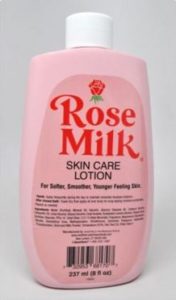When we were growing up, my sister and I were fortunate enough to live close to our grandparents. On many a Saturday we would pack our little suitcases and head on over for roller skating in the garage, tea parties with our 6-foot-plus grandpa, Kraft mac ‘n’ cheese and fish stick dinners and pretend grocery shopping in the oversized pantry (also in the garage, and complete with a mini shopping cart!).
Saturday night was TV night. If we were lucky, we could stay up and watch The Love Boat. (I should have put lucky in quotes. You’d be hard-pressed to find a cheesier show. Or one with more of an ear worm theme song. Those of a certain age: I know you can still sing it. Go ahead. Click on the link. I dare you.)
The Love Boat didn’t come on until 9:00. Before then, we had to get through the grandparental favorites: Hee Haw and Lawrence Welk. I watched enough of both to sing along with this Hee Haw song and become intimately familiar with Welk’s commercial plugs for Rose Milk Skin Cream. (Later, in high school, my friend Gina would flawlessly imitate Welk’s famous accent: “Thank you, thank you, Bobbie and Suzy, for that wonderful polka!”)

It turns out that Rose Milk Skin Cream is still sold – at WalMart (and other fine establishments)! Surprise! (Sorry – that was quite snarky of me.) A quick look at the label shows that it is full of nasty things like parabens and artificial colors and long names of ingredients that I learned in high school chemistry but have since forgotten.
Traditionally, creams and lotions are a mix of oil, water and beeswax. My favorite DIY cream so far – and possibly the inspiration for the product pushed by Lawrence Welk and his lackeys – is Rosemary’s Famous Face Cream.
Rosemary Gladstar is the godmother of the revitalized herbalism movement in the U.S. and one of the co-founders of Traditional Medicinal teas. We owe her amazing face cream to hours of experimentation. Rosemary literally wrote the book(s) on herbalism: when she was trying to (re-)create lotions and creams, no books existed on how to do it.
The recipe below includes her tested method for ensuring you’re able to mix oil and water without it separating and some tips on what to do if your base is too thick or too thin. One batch makes enough for several months, even if you share some with friends.
Rosemary’s Famous Face Cream
Ingredients (make sure all are at room temperature before using):
Oil Base:
- 3/4 cup liquid oils, any combination amount that you prefer of almond and apricot kernel oil. You can also use grapeseed or herbal-infused oils as well; you decide what’s best for your skin type and purpose, as long as all the oils you decide to use measure this amount when combined with each other.
- 1/3 cup Coconut and Cocoa Butter (combined together to equal 1/3 cup)
- 1/2 ounce Beeswax
Water Base:
- 1/2 cup water (you can use distilled, rose water, hydrosols, orange blossom
water, etc.) - 1/2 cup Aloe Vera Gel
Optional:
- Any combination of essential oils you prefer. The traditional recipe calls for 5-10 drops each of grapefruit, ylang ylang, and patchouli oils. I love to use rose-geranium, orange, or lavender essential oils.
- Heat the oil base in a double boiler over low heat on the stove until it melts (about 10 minutes). Let it cool completely until it reaches room temperature. This will take a few hours. You can also leave it sitting out overnight and proceed with making the cream the following day. You want it to be a creamy thick consistency. If your base is too thick you will need to add more oils; if it’s too thin you’ll need to add more beeswax.
- Combine the water base from whichever water options you have chosen with the aloe vera gel. Then place your cooled-off oil base into a glass blender. At this point you can add your essential oils into the oil base in the blender. Start with 5-10 drops of each. They will be diluted when you add the water to the base. So make sure you add slightly more according to what smells the best to you to retain the fragrance when you add the waters.
- Blend the essential oils with the oil base in the blender and do a smell check to see if you need to adjust your fragrance. Once the fragrance is right, put the lid on and turn your blender on a higher speed setting and slowly drizzle your water base through the opening in lid. If your blender doesn’t have an opening in the lid, then carefully add the water to the oil base using the lid as a splash guard.
- You want to listen to your blender’s motor. Once the motor’s sound changes and the mixture is getting thicker, you should hear the motor slow down. Turn off your blender and your cream should be done. If you did not add all liquids, you can stir cream together and slowly try to add the rest of liquid or liquids, being careful not to strain your blender’s motor. Be very careful not to over whip or it will separate. The consistency will be runny, but it will thicken as it sets and cools.
The best way to store is in a glass jar that has a lid with any paper lining removed. This will keep for several months.
If you are looking for a place to buy ingredients, check out your local health food store, Mountain Rose Herbs, Starwest Botanicals or the Dandelion Botanical Company in Seattle.
